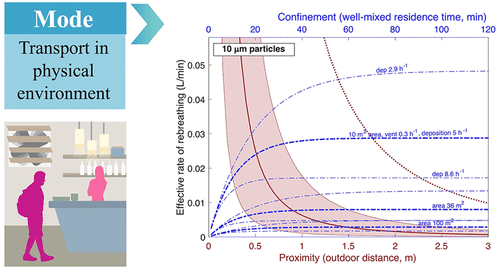当前位置:
X-MOL 学术
›
Environ. Sci. Technol.
›
论文详情
Our official English website, www.x-mol.net, welcomes your feedback! (Note: you will need to create a separate account there.)
Quantifying Proximity, Confinement, and Interventions in Disease Outbreaks: A Decision Support Framework for Air-Transported Pathogens
Environmental Science & Technology ( IF 11.4 ) Pub Date : 2021-02-19 , DOI: 10.1021/acs.est.0c07721 Tami C Bond 1 , Angela Bosco-Lauth 2 , Delphine K Farmer 3 , Paul W Francisco 4, 5 , Jeffrey R Pierce 6 , Kristen M Fedak 7 , Jay M Ham 8 , Shantanu H Jathar 1 , Sue VandeWoude 9
Environmental Science & Technology ( IF 11.4 ) Pub Date : 2021-02-19 , DOI: 10.1021/acs.est.0c07721 Tami C Bond 1 , Angela Bosco-Lauth 2 , Delphine K Farmer 3 , Paul W Francisco 4, 5 , Jeffrey R Pierce 6 , Kristen M Fedak 7 , Jay M Ham 8 , Shantanu H Jathar 1 , Sue VandeWoude 9
Affiliation

|
The inability to communicate how infectious diseases are transmitted in human environments has triggered avoidance of interactions during the COVID-19 pandemic. We define a metric, Effective ReBreathed Volume (ERBV), that encapsulates how infectious pathogens, including SARS-CoV-2, transport in air. ERBV separates environmental transport from other factors in the chain of infection, allowing quantitative comparisons among situations. Particle size affects transport, removal onto surfaces, and elimination by mitigation measures, so ERBV is presented for a range of exhaled particle diameters: 1, 10, and 100 μm. Pathogen transport depends on both proximity and confinement. If interpersonal distancing of 2 m is maintained, then confinement, not proximity, dominates rebreathing after 10–15 min in enclosed spaces for all but 100 μm particles. We analyze strategies to reduce this confinement effect. Ventilation and filtration reduce person-to-person transport of 1 μm particles (ERBV1) by 13–85% in residential and office situations. Deposition to surfaces competes with intentional removal for 10 and 100 μm particles, so the same interventions reduce ERBV10 by only 3–50%, and ERBV100 is unaffected. Prior knowledge of size-dependent ERBV would help identify transmission modes and effective interventions. This framework supports mitigation decisions in emerging situations, even before other infectious parameters are known.
中文翻译:

量化疾病爆发中的邻近性、限制性和干预措施:空气传播病原体的决策支持框架
由于无法传达传染病如何在人类环境中传播,导致人们在 COVID-19 大流行期间避免互动。我们定义了一个指标,即有效再呼吸量 (ERBV),它概括了包括 SARS-CoV-2 在内的传染性病原体如何在空气中传播。ERBV 将环境传播与感染链中的其他因素分开,从而可以对情况进行定量比较。颗粒大小会影响传输、表面清除以及通过缓解措施消除,因此 ERBV 针对一系列呼出颗粒直径提供:1、10 和 100 μm。病原体的运输取决于距离和限制。如果保持 2 m 的人际距离,那么对于除 100 μm 颗粒之外的所有颗粒而言,在封闭空间 10-15 分钟后,再呼吸的主导因素是限制,而不是接近。我们分析了减少这种限制效应的策略。在住宅和办公室环境中,通风和过滤可将人与人之间 1 μm 颗粒 (ERBV 1 ) 的传播减少 13–85%。表面沉积与 10 和 100 μm 颗粒的有意去除相竞争,因此相同的干预措施仅使 ERBV 10降低3-50%,而 ERBV 100不受影响。对大小依赖性 ERBV 的先验知识将有助于确定传播模式和有效的干预措施。该框架支持新兴情况下的缓解决策,甚至在其他传染性参数已知之前。
更新日期:2021-03-02
中文翻译:

量化疾病爆发中的邻近性、限制性和干预措施:空气传播病原体的决策支持框架
由于无法传达传染病如何在人类环境中传播,导致人们在 COVID-19 大流行期间避免互动。我们定义了一个指标,即有效再呼吸量 (ERBV),它概括了包括 SARS-CoV-2 在内的传染性病原体如何在空气中传播。ERBV 将环境传播与感染链中的其他因素分开,从而可以对情况进行定量比较。颗粒大小会影响传输、表面清除以及通过缓解措施消除,因此 ERBV 针对一系列呼出颗粒直径提供:1、10 和 100 μm。病原体的运输取决于距离和限制。如果保持 2 m 的人际距离,那么对于除 100 μm 颗粒之外的所有颗粒而言,在封闭空间 10-15 分钟后,再呼吸的主导因素是限制,而不是接近。我们分析了减少这种限制效应的策略。在住宅和办公室环境中,通风和过滤可将人与人之间 1 μm 颗粒 (ERBV 1 ) 的传播减少 13–85%。表面沉积与 10 和 100 μm 颗粒的有意去除相竞争,因此相同的干预措施仅使 ERBV 10降低3-50%,而 ERBV 100不受影响。对大小依赖性 ERBV 的先验知识将有助于确定传播模式和有效的干预措施。该框架支持新兴情况下的缓解决策,甚至在其他传染性参数已知之前。

























 京公网安备 11010802027423号
京公网安备 11010802027423号